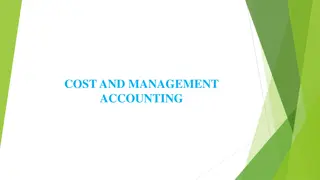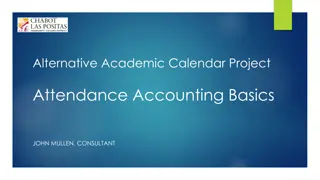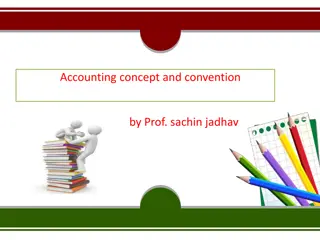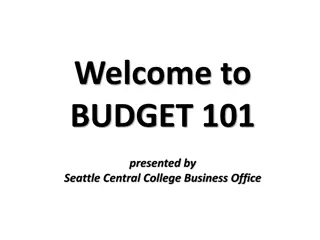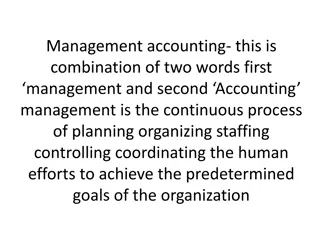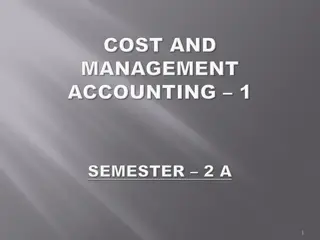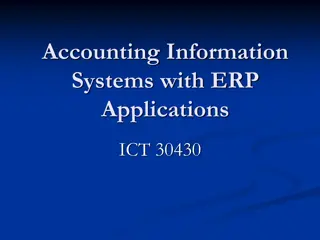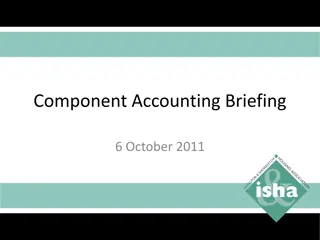OVERVIEW OF BASICS OF ACCOUNTING
Explore the evolution of accounting practices from ancient times to modern standards, including the role of Luca Pacioli, industrial revolution impacts, and the establishment of accounting standards by ICAI in India. Discover the basic principles of Generally Accepted Accounting Principles (GAAP) and the history of accounting in both global and Indian contexts.
Download Presentation

Please find below an Image/Link to download the presentation.
The content on the website is provided AS IS for your information and personal use only. It may not be sold, licensed, or shared on other websites without obtaining consent from the author.If you encounter any issues during the download, it is possible that the publisher has removed the file from their server.
You are allowed to download the files provided on this website for personal or commercial use, subject to the condition that they are used lawfully. All files are the property of their respective owners.
The content on the website is provided AS IS for your information and personal use only. It may not be sold, licensed, or shared on other websites without obtaining consent from the author.
E N D
Presentation Transcript
OVERVIEW OF BASICS OF ACCOUNTING CA KALPESH P. PAREKH CA, CS, B.COM, M.COM PAST CHAIRMAN, RAJKOT BRANCH OF WIRC COMMITTEE ON PUBLIC AND GOVERNMENT FINANCIAL MANAGEMENT, ICAI
History of Accounting in world and India Luca Pacioli, an Italian monk, published Summa de Arithmetica, a book that introduced the double- entry system for bookkeeping and laid the groundwork for the future of accounting. Accounting practices that took place during the overall historic periods within this time frame include the following: Stone age Marking ticks on cave walls and mountains, and in the jungle to record goods collected and loaned Primitive Noting symbols on walls and making rope knots to designate transactions Barter Recording deals made through barter for agricultural or other property Currency Tracking monetary transactions, originally in Europe, related to transactions that bank loans financed.
History of Accounting in world and India Due to industrial development and manufacturing-based economy, accounting method evolved. Industrial revolution Required tracking the large amounts of capital involved in establishing new corporations and railroads Joint-stock companies Added complexity to doing business, with the financial concerns of shareholders and other business partners becoming factors Government regulation Led to the development of uniform accounting practices to accommodate tax laws The history of the accounting industry in India can be traced back to the early 20th century when the country's first chartered accountancy firms were established. However, accounting practices in India could be traced back to a period when twenty three centuries ago, Kautilya, a minister in Chandragupta s kingdom wrote a book named Arthashasthra, which also described how accounting records had to be maintained.
Basic structure of Accounting and its Standards The Institute of Chartered Accountants of India (ICAI), being a premier accounting body in the country, took upon itself the leadership role by constituting the Accounting Standards Board (ASB) in 1977. Consideration of the final draft of the proposed standard by the Council of the ICAI and if found necessary, modification of the draft in consultation with the ASB is done. ICAI in consultation with ASB, with Generally Accepted Accounting Principles (GAAP), issues Accounting standards, which provide the framework for more detailed and comprehensive accounting rules.
Generally Accepted Accounting Principles (GAAP) 1.Principle of Regularity: strictly adhere to established rules and regulations. 2.Principle of Consistency: Consistent standards are applied throughout the financial reporting process. 3.Principle of Sincerity: committed to accuracy and impartiality. 4.Principle of Permanence of Methods: Consistent procedures are used in the preparation of all financial reports. 5.Principle of Non-Compensation: All aspects of an organization's performance, whether positive or negative, are fully reported with no prospect of debt compensation. 6.Principle of Prudence: Speculation does not influence the reporting of financial data. 7.Principle of Continuity: Asset valuations assume the organization's operations will continue. 8.Principle of Periodicity: Reporting of revenues is divided by standard accounting periods, such as fiscal quarters or fiscal years. 9.Principle of Materiality: Financial reports fully disclose the organization's monetary situation. 10.Principle of Utmost Good Faith: All involved parties are assumed to be acting honestly.
Fundamental (Golden Rules of Accouting) A nominal account is a general ledger containing the transactions of a business, namely expenses, incomes, profits and losses. You can think of a personal account as a general ledger that relates to people, associations and companies. A Real account is also a general ledger, but it contains transactions related to the liabilities and assets of a company.
Meaning of Financial Reporting & Framework of the same in India Financial reporting is a systematic process of recording and representing a company s financial data. The reports reflect a firm s financial health and performance in a given period. Management, investors, shareholders, financiers, government, and regulatory agencies rely on financial reports for decision-making. ( . , .) . , , , Financial reports include financial statements, notes to accounts, cash flow statements and such other requisition by MCA for complying with the same in case of company. These reports are crucial for strategizing the future growth and sustainability of a firm. ( , , .)
Meaning of Financial Reporting & Framework of the same in India The Institute of Chartered Accountants of India (ICAI), being a premier accounting body in the country, took upon itself the leadership role by constituting the Accounting Standards Board (ASB) in 1977. The ICAI has taken significant initiatives for the issuance of Accounting Standards to ensure that the standard-setting process is fully consultative and transparent. (ICAI . .)
Major Components of the Financial Reporting Balance Sheet ( ) portrays value of economic resources controlled by an enterprise. It also provides information about liquidity and solvency of an enterprise which is useful in predicting the ability of the enterprise to meet its financial commitments as they fall due. ( .) Statement of Profit and Loss( ) presents the result of operations of an enterprise for an accounting period, i.e., it depicts the performance of an enterprise, in particular its profitability. ( .) Cash Flow Statement ( ) shows the way an enterprise has generated cash and the way they have been used in an accounting period and helps in evaluating the investing, financing and operating activities during the reporting period. ( .)
Major Components of the Financial Reporting Notes and other statements ( ) present supplementary information explaining different items of financial statements. For example, they may contain additional information that is relevant to the needs of users about the items in the balance sheet and statement of profit and loss. They include various other disclosures such as disclosure of accounting policies, segment reporting, related party disclosures, earnings per share, etc.( .)
Components of Balance Sheet: Assets & Liability Equity & Liabilities Shareholders funds Non-Current Liabilities Current Liabilities Long-term Borrowings Short-Term Borrowings Share Capital Trade Payables Reserves & Surplus Long term Provisions Other Current Liabilities Short-Term Provisions Other LT Liabilities
Components of Balance Sheet: Assets & Liability Assets Non-Current Assets Current Assets Long Term Loans & Advances Non-Current Investments Current Investments Fixed Assets Inventories Capital Work-in- Progress Trade Receivables Cash & Cash Equivalents Tangible Assets Intangible Assets under Development Short Term Loans & Advances Intangible Assets
Components of Balance Sheet (Performa of Balance Sheet as per Schedule-III)
Components of Balance Sheet (Performa of Balance Sheet as per Schedule-III)
Meaning of Various terms Inflow ( ) Income Outflow ( ) Expense
Components of Profit & Loss Statement (Performa of P&L as per Schedule-III)
Components of Profit & Loss Statement (Performa of P&L as per Schedule-III)
Interpretation of Financial Statement Interpretation of Financial Statements Profitability Ratios Related Party Transaction Investors Ratio Limitations Liquidity Ratio Window Dressing EPS GP Margin NP Margin Current Ratio Net Asset Turnover P/E Ratio Limited information available ROCE Quick Ratio Historical Coast Accounting
Interpretation of Financial Statement Particulars of Ratio 1) Gross Profit Ratio ( ) 2) Net Profit Ratio ( ) 3) Current Ratio ( ) 3) Inventory Turnover Ratio ( ) 4) Debt to Equity Ratio ( ) 5) Earning per Share ( ) Formula of Ratio Gross Profit/Net Sales ( / ) Net Profit/Net Sales ( ( ) / ) Current Assets/Current Liabilities ( / ) Closing Inventory/Net Sales ( / ) Total Liabilities/Shareholder s fund ( / ) Net Profit (Net Earnings)/Total Shares outstanding ( / )
Interpretation of Financial Statement 1. Gross Profit= Net Sales (Sales- Sales Return)- Purchase- Direct Expense- Opening Stock+ Closing Stock ( = ( - )- - - + ) 2. Net Profit= Gross Profit- Indirect Expense+ Indirect Income ( = - + ) 3. Current Assets are those assets which can be realized in cash or cash equivalent within a period of 12 Months and for the Current liabilities vice-versa. ( .)
Bank Reconciliation Statement Bank reconciliation is - The process of comparing the balance as per the cash book with the balance as per the passbook (bank statement). - The very purpose of reconciling the bank statement with your business books of accounts is to identify any differences between the balance of the two accounts. (' ( ) . . )
Bank Reconciliation Statement To reconcile a bank statement with your business' books of accounts, you need to follow the steps below: ( :) Match each of the deposits recorded in your books of accounts to the ones reflected in your bank statement. There might be a possibility that your bank might have denied accepting a cheque within a collection of deposited cheques or might have recorded an incorrect cheque amount. In case this happens, you should add back the amount of rejected cheques to the bank s closing cash balance. ( . .)
Bank Reconciliation Statement Next, prepare a list of cheques that have not been cleared by the bank. Cheques presented but not cleared are reconciling items and need to be deducted from the bank s closing cash balance for your account. ( .) Then, check the miscellaneous debits and credits listed on your bank statement and add or subtract the same from the reconciliation. ( , .) Finally, add or subtract all the items marked as reconciling items from your bank s closing cash balance. Once you have identified all the differences and prepared a bank reconciliation statement, attach the bank reconciliation statement with the rest of your accounting records for future reference. ( .)
Bank Reconciliation Statement Example: From the Following Particulars of M/s. Zen Enterprise prepare Bank Reconciliation Statement as on 31/03/2023. Amount in Rupees 20,000 Particulars Overdraft as per passbook Interest on overdraft An insurance premium paid by the bank Cheques issued but not presented for payment Cheques deposited but not yet cleared Wrongly debited by the bank 2,000 200 6,500 6,000 500
Bank Reconciliation Statement Answer: Bank Reconciliation Statement as on March 31, 2023 Particulars Overdraft as per passbook Add: Interest on overdraft Add: An insurance premium paid by the bank Less: Cheques issued but not presented for payment Add: Cheques deposited but not yet cleared Add: Wrongly debited by the bank Overdraft balance as per cash book Amount Rs. (20,000) 2,000 200 (6,500) 6,000 500 (17,800)
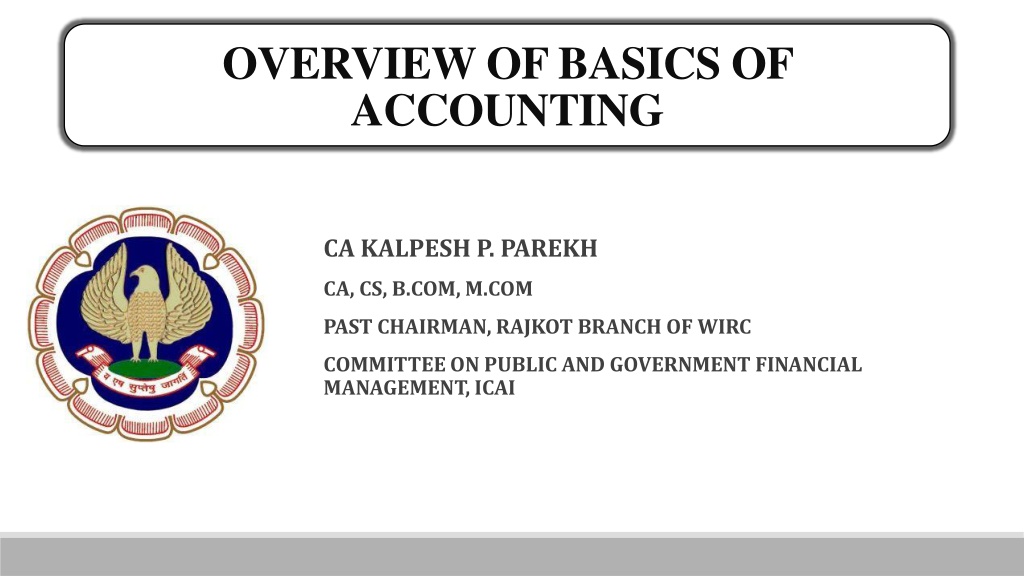






 undefined
undefined







